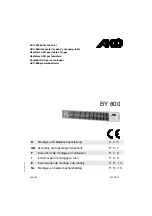
GB
9
■
A wrench size 17.
■
Approved leak spray or foaming agent.
Important.
Follow the safety information
(section 2)
Note:
The gas cylinder must be set up in such a
way that the hose line is not kinked or twisted,
is not subjected to tension and does not touch
any hot areas of the gas fan heater.
6.2.2 Making the connections
1. (Fig. 1) Use a wrench size 17 to connect the
gas hose to the gas connection thread (3) of
the gas fan heater. Tighten the connection.
2. (Fig. 2) Connect the union nut (D) of the
pressure regulator (E) to the cylinder valve
thread (G) by turning it counter-clockwise.
Do not use any tools – the cylinder valve
gasket could be damaged, resulting in a
leak.
3. (Fig. 2) Connect the hose line (N) to the
pressure regulator output thread (K) with a
suitable wrench size 17, turning it counter-
clockwise. To tighten, you must hold a
second wrench of the correct size on the
pressure regulator (faces are provided on
the pressure regulator for this purpose) in
order to stop the regulator being turned or to
stop too much force being transferred.
Tightening the connection as just described
will prevent leaks.
4. Use a leak tester to check all the
connections under operating pressure. If no
bubbles form, the connection is not leaking.
It is prohibited to conduct a leak test with a
naked flame. Porous or damaged hose lines
and fittings must be replaced immediately.
6.2.3 Replacing the gas cylinder (Fig. 2)
Important. Read the safety information
1. The liquid gas cylinder must be changed in
a well ventilated area or outdoors away from
naked flames (candles, cigarettes, other
devices with a naked flame, etc.).
2. Close the cylinder valve (F)
3. Undo the union nut (D) on the pressure
regulator
4. Take the pressure regulator (E) off the
cylinder
5. Screw a guard cap onto the cylinder valve
thread (G)
6. Connect the new cylinder as described in
section 6.2.2
7. Using the equipment
7.1 Starting up
Notes:
■
Before starting up the gas fan heater and in
particular after a lengthy period of non-use,
check the gas carrying parts for blockages
caused by insects, etc. If the gas pipes are
blocked, a dangerous flashback may occur.
■
Do not start up the gas fan heater until you
are certain that the gas hose and its
connections are not leaking (see section
7.1.1).
■
Check that the voltage supply is the same
as the voltage details on the rating plate.
■
If a leak develops during operation, close
the gas cylinder valve immediately and
open all the windows and doors.
7.1.1 Testing for leaks
With the gas cylinder valve open and the
pressure regulator closed, spray leak detection
spray on all the screw connections you have
made in order to check for leaks. If there is a
leak, bubbles will form at this position. In this
case close the cylinder valve immediately and
re-tighten the screw connections. Then check
for leaks again. If the leak remains after several
attempts, please contact Customer Service.
7.1.2 Switching on the gas fan heater
(Fig. 1)
Important. When you switch on the gas fan
heater, always stand behind or on the side of
the equipment and never in front of the air outlet
opening – risk of burns.
Notes:
■
Do not move the gas fan heater when it is in
operation
■
The gas fan heater becomes hot when it is
in operation – risk of burns.
Anleitung_2330444_DK:_ 10.06.2011 11:16 Uhr Seite 9
Summary of Contents for 23.304.44
Page 3: ...3 1 5 1 2 3 9 7 8 4 6 Anleitung_2330444_DK _ 10 06 2011 11 16 Uhr Seite 3...
Page 15: ...15 GB 15 Spare parts drawing Anleitung_2330444_DK _ 10 06 2011 11 16 Uhr Seite 15...
Page 28: ...28 DK 15 Reservedelstegning Anleitung_2330444_DK _ 10 06 2011 11 16 Uhr Seite 28...
Page 31: ...31 Anleitung_2330444_DK _ 10 06 2011 11 16 Uhr Seite 31...
Page 32: ...32 Anleitung_2330444_DK _ 10 06 2011 11 16 Uhr Seite 32...
Page 33: ...33 Anleitung_2330444_DK _ 10 06 2011 11 16 Uhr Seite 33...










































